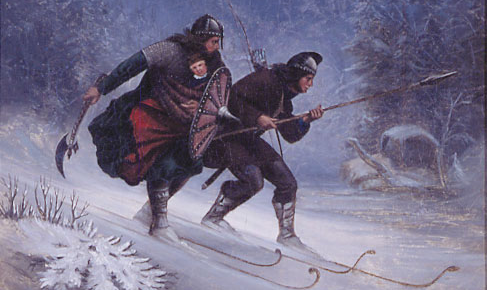
Yellowstone has many options for cross country skiers looking to take their skills to the next level. You'll find everything you need, from ski rentals to guided tours to equipment sales.
There are more than 40 miles worth of trails in Yellowstone, making it a great place to go Nordic skiing. You can find beginner-friendly trails if you're just getting started. You can also explore many other trails. If you want to go outside the park, snowmobiles can be used.
Some of the most popular trails in this area include the Rendezvous Ski Trails, West Yellowstone, and others. These trails are of world-class quality and attract U.S. Nordic Team members as well as other visitors. There are also skate skiing lessons offered at these locations.

The Bighorn Pass Trail offers another option for those who love the thrill of skiing on snow. This trail is available in a range levels of difficulty. It has gentle slopes as well as steep and steep slopes. Partner is recommended because of the increased avalanche danger. A rental of an avalanche receiver may be possible.
The Upper Terrace Loop provides a great place to ski for anyone who wants to see the geothermal elements in the Mammoth Hot Springs Area. Cross country skiers can use this loop. This scenic route will allow you to see Madison and Gallatin mountains.
The West Yellowstone is home to some of the best Nordic skiing in the Yellowstone Area. You will find hundreds of miles worth of trails through the park, both groomed and ungroomed. You can cover a lot of terrain on these trails, depending on your experience and skill. The National Park Service has rated many of these trails.
Harriman State Park can also offer skiing opportunities and is located only an hour drive from West Yellowstone. Harriman offers plenty of terrain, including ungroomed tracks and skating lanes. Most roads in Harriman are closed to snow travel during the winter months, which is between mid-December through mid-March.

Layers of clothing are recommended for winter visits to the park. If you're not used to the cold, be aware of signs such as hypothermia or frostbite. Deer and pine martens are also important to be aware. Before you leave, please make sure to provide your contact information at the visitor's center.
Stop by the Taste of the Trails festival while you're in the park. This supported 5K race allows skiers of any level to explore the region. Several food stations are available along the route, allowing you to stop for a bite of delicious food along the way.
FAQ
Where should I store my luggage
There are many choices. The most popular option is to use lockers in airports. These are normally located near the security area. They can be purchased for between $5-10 per daily, depending upon the size of the locker.
A storage unit can be rented. These units are often located in large shopping centers or hotels. Although prices vary, some places offer discounts for multiple units that are rented together.
You can also hire a porter. A porter will transport your luggage from the carousel into your room. For each porter you hire, you pay a small amount.
What is the first thing you should do upon arriving at your travel destination
You should always have an itinerary for when you arrive at a place. It will let you know what to expect, and where to go next.
Planning ahead is essential to avoid being late for any important events.
You should also research what museums, parks, or landmarks you want to visit if you are planning to visit a city more than once.
It might be worth looking into getting a map for the area or reading about the history of this region.
Should I get travel insurance?
Travel insurance is important if your plans include adventure travel. It is important to have insurance that covers all types of adventure sports.
For example, if you are skiing, you should ensure that you have medical coverage. You should also think about getting coverage for theft loss and damage.
Cover for cancellation should be considered. This allows you to cancel your holiday without having to pay any penalties.
You should also ask for coverage for emergency evacuation. You can also be taken off the mountain in the event of an avalanche, or another natural disaster.
Statistics
- They're also likely to offer babysitting services, in case you'd like to have dinner one night after 7 p.m. (travelandleisure.com)
- Alcoholic beverages with 24% alcohol or less are not subject to limitations in checked bags. (tsa.gov)
- You can use compression sacs or cubes to reduce the volume of your clothes by up to 80%—this is especially convenient for bulky items such as sweaters and jackets. (eaglecreek.com)
- No Checked Bags: No Alcoholic beverages with more than 70% alcohol (over 140 proof), including grain alcohol and 151 proof rum. (tsa.gov)
- That's an 18% jump from 2019, the previous record year. (travelandleisure.com)
External Links
How To
How to plan your next vacation
Planning a trip includes many things such as booking flights, hotels and car rentals. You must also consider your budget, destination, weather forecast, and other important factors.
You should always remember these points while planning your next vacation.
We have prepared a step-by, step guide to help with your next vacation planning. This guide has been prepared based on our experience and customer feedback. We hope that by following this guide, you can plan your next vacation without any hassle.
Steps:
-
Your Budget is an important step in planning your trip. Before you begin planning for your trip, you need to know how much money it is you are willing and able to spend. In the event that you don't have enough cash, you might need to cancel your plans.
-
Book Flights – After setting your budget, you must book your flights. Be sure to get the lowest price flight deal. Make sure to check for special offers during peak seasons. These deals may save you money.
-
Choose Your Destination - Once you've booked your ticket, the next thing you'll need to decide is where you'd like to travel. Multiple factors come into play when choosing your destination, including location (where you're going), climate (what season to visit), culture (how friendly people are), and cost (how affordable it is).
-
Find Accommodations - After choosing your destination, the next step would be finding accommodations. There are many accommodation options available, from inexpensive hostels to luxury suites. It all depends on what you want and how much space you have. If you need to be near the city center, a hotel may not suit your needs. On the other hand, if you prefer quiet places away from crowds, a homestay may suit your requirements better.
-
Select Activities & Attractions. After you have chosen your accommodation, now it's time to choose the activities and attractions that will be included in your itinerary. Depending on your length of stay, you may choose to add or remove activities.
-
You can now determine your schedule. Sticking to a plan will help you maximize the value of your trip. You can still enjoy your trip if you are able to travel at your own pace.
-
You can create an itinerary by creating itineraries. From flights to accommodation, activities to restaurants, you should write them down and create a list of things to remember.
-
Research online - Make sure you do your research before you leave for your trip. Read reviews and testimonials to find out what other travelers think about different destinations. You will be able plan accordingly.
-
Don't Overpack - This is one of the most common mistakes people make when packing. Instead of bringing five sets of clothes, bring three. Wear clothing that is appropriate for the climate you are visiting.
-
Always be prepared Before you leave for your trip, make sure that everything is in order. You don't want to waste time searching for important documents while you're still in transit.